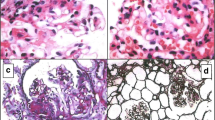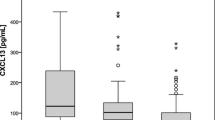Abstract
The aim of this study was to investigate the levels and clinical significance of serum soluble chemokine (C-X-C motif) ligand 16 (sCXCL16) in patients with systemic lupus erythematosus (SLE), as well as the sCXCL16 molecule’s associations with disease activity and organ damage. Thirty-five patients with SLE, 16 patients with rheumatoid arthritis (RA), and 15 healthy controls were included in this study. The demographic and clinical features of the patients were recorded. The serum levels of sCXCL16 were determined. Disease activity was assessed using the SLE Disease Activity Index (SLEDAI), and organ damage was evaluated with the Systemic Lupus International Collaborating Clinics/American College of Rheumatology (SLICC/ACR) Damage Index (SDI). The serum levels of sCXCL16 in the patients with SLE were higher than those in the patients with RA (P = 0.002) or healthy controls (P < 0.0001). The levels in the patients with active SLE were higher than those in the disease inactive patients (P = 0.008). Positive correlations were identified between serum sCXCL16 concentrations and both SLEDAI (r = 0.564; P < 0.0001) and SDI scores (r = 0.396; P = 0.018). Both SLEDAI (P = 0.021) and serum levels of CXCL16 (P = 0.023) decreased after conventional treatment in 12 initial onset cases of SLE patients. Elevated serum sCXCL16 levels were discovered in the SLE patients with cutaneous (P = 0.006) and renal involvement (P = 0.032). Soluble CXCL16 may become a useful serological marker of disease activity and skin and renal involvement in SLE patients; thus, it may be used for evaluation of therapeutic interventions.




Similar content being viewed by others
References
Minami M, Kume N, Shimaok T et al (2001) Expression of SR-PSOX, a novel cell-surface scavenger receptor for phosphatidylserine and oxidized LDL in human atherosclerotic lesions. Arterioscler Thromb Vasc Biol 21(11):1796–1800
Matloubian M, David A, Engel S et al (2000) A transmembrane CXC chemokine is a ligand for HIV-coreceptor Bonzo. Nat Immunol 1(4):98–304
Anja S, Mohamed SAB, Nicole KK et al (2008) The role of CXCL16 and its processing metalloproteinases ADAM10 and ADAM17 in the proliferation and migration of human mesangial cells. Biochem Biophys Res Commun 370(2):311–316
Jan HR, Hans JP, Jan ET et al (2012) Immature renal dendritic cells recruit regulatory CXCR6 + invariant natural killer T cells to attenuate crescentic GN. J Am Soc Nephrol 23(12):1987–2000
Oliver H, Thomas E, Nicholas JS et al (2011) SR-PSOX at sites predisposed to atherosclerotic lesion formation mediates monocyte-endothelial cell adhesion. Atherosclerosis 217(2):371–378
Caroline D, Rashmika P, Cristina G et al (2009) The chemokine CXCL16 is highly and constitutively expressed by human bronchial epithelial cells. Exp Lung Res 35(4):272–283
Wehr A, Baeck C, Heymann F et al (2013) Chemokine receptor CXCR6-dependent hepatic NK T Cell accumulation promotes inflammation and liver fibrosis. J Immunol 190(10):5226–5523
Isozaki T, Arbab AS, Haas CS et al (2013) Evidence that CXCL16 is a potent mediator of angiogenesis and is involved in endothelial progenitor cell chemotaxis studies in mice with K/BxN serum-induced arthritis. Arthritis Rheum 65(7):1736–1746
Yunfeng X, Mark LE, Yanlin W et al (2013) Critical role of CXCL16 in hypertensive kidney injury and fibrosis. Hypertension 62(6):1129–1137
Yilmaz S, Cinar M, Pekel A et al (2013) The expression of transmembrane and soluble CXCL16 and the relation with interferon-alpha secretion in patients with Behcet’s disease. Clin Exp Rheumatol 31(3):84–87
Qi G, Fan W, Xuebo P et al (2012) Soluble C-X-C chemokine ligand 16 levels are increased in gout patients. Clin Biochem 45(16–17):1368–1373
Petri M, Orbai AM, Alarcon GS et al (2012) Derivation and validation of the systemic lupus international collaborating clinics classification criteria for systemic lupus erythematosus. Arthritis Rheum 64(8):2677–2686
Aletaha D, Neogi T, Silman AJ et al (2010) 2010 Rheumatoid arthritis classification criteria: an American College of Rheumatology/European League Against Rheumatism collaborative initiative. Arthritis Rheum 62(9):2569–2581
Gladman DD, Lbanez D, Urowitz MB (2002) Systemic lupus erythematosus Disease Activity Index 2000. J Rheumatol 29(2):288–291
Gladman D, Ginzler E, Goldsmith C et al (1996) The development and initial validation of the Systemic Lupus International Collaborating Clinics/American College of Rheumatology damage index for systemic lupus erythematosus. Arthritis Rheum 39(3):363–369
Gladman DD, Goldsmith CH, Urowitz MB et al (2000) The Systemic Lupus International Collaborating Clinics/American College of Rheumatology (SLICC/ACR) Damage Index for systemic lupus erythematosus international comparison. Arthritis Rheum 27(2):373–376
Bazan JF, Bacon KB, Hardiman G et al (1997) A new class of membrane-bound chemokine with a CX3Cmotif. Nature 385(6617):640–644
Chandrasekar B, Mummidi S, Valente AJ et al (2005) The pro-atherogenic cytokine interleukin-18 induces CXCL16 expression in rat aortic smooth muscle cells via MyD88, interleukin-1 receptor-associated kinase, tumor necrosis factor receptor-associated factor 6, c-Src, phosphatidylinositol 3-kinase, Akt, c-Jun N-terminal kinase, and activator protein-1 signaling. J Biol Chem 280(28):26263–26277
Nanki T, Shimaoka T, Hayashida K et al (2005) Pathogenic role of the CXCL16–CXCR6 pathway in rheumatoid arthritis. Arthritis Rheum 52(10):3004–3014
Van der Voort R, Van Lieshout AW, Toonen LW et al (2005) Elevated CXCL16 expression by synovial macrophages recruits memory T cells into rheumatoid joints. Arthritis Rheum 2005(52):1381–1391
López P, Gómez J, Prado C et al (2008) Influence of functional interleukin 10/tumor necrosis factor-alpha polymorphisms on interferon-alpha, IL-10, and regulatory T cell population in patients with systemic lupus erythematosus receiving antimalarial treatment. J Rheumatol 35(8):1559–1566
Tucci M, Lombardi L, Richards HB et al (2008) Overexpression of interleukin-12 and T helper 1 predominance in lupus nephritis. Clin Exp Immunol 154(2):247–254
Yap DY, Lai KN (2010) Cytokines and their roles in the pathogenesis of systemic lupus erythematosus: from basics to recent advances. J Biomed Biotechnol 2010:365083
Gómez D, Correa PA, Gómez LM et al (2004) Th1/Th2 cytokines in patients with systemic lupus erythematosus: is tumor necrosis factor alpha protective? Semin Arthritis Rheum 33(6):404–413
Sabry A, Sheashaa H, El-Husseini A et al (2006) Proinflammatory cytokines (TNF-alpha and IL-6) in Egyptian patients with SLE: its correlation with disease activity. Cytokine 35(3–4):148–153
Sabry A, Elbasyouni SR, Sheashaa H et al (2006) Correlation between levels of TNF-alpha and IL-6 and hematological involvement in SLE Egyptian patients with lupus nephritis. Int Urol Nephrol 38(3–4):731–737
Liang K, Liu H, Liao L et al (2004) Th1/Th2 cytokine imbalance in patients with lupus nephritis. Chin J Rheumatol 8(11):671–674
Peeters MA, Chizzolini C (2011) Cardiovascular risk in autoimmune and inflammatory disorders. Rev Med Suisse 291(7):867–871
Abel S, Berkhout TA, Hundhausen C et al (2004) The transmembrane CXC-chemokine ligand 16 is induced by IFN-gamma and TNF-alpha and shed by the activity of the disintegrin-like metalloproteinase ADAM10. J Immunol 172(10):6362–6372
Tohyama M, Sayama K, Komatsuzawa H et al (2007) CXCL16 is a novel mediator of the innate immunity of epidermal keratinocytes. Int Immunol 19(9):1095–1102
Tenger C, Sundborger A, Jawien J et al (2005) IL-18 accelerates atherosclerosis accompanied by elevation of IFN-gamma and CXCL16 expression independently of T cells. Arterioscler Thromb Vasc Biol 25(4):791–796
Schallhorn RA, Patel DN, Chandrasekar B et al (2010) Periodontal disease in association with systemic levels of interleukin-18 and CXC ligand 16 in patients undergoing cardiac catheterization. J Perinatol 81(8):1180–1186
Scholz F, Schulte A, Adamski F et al (2007) Constitutive expression and regulated release of the transmembrane chemokine CXCL16 in human and murine skin. J Investig Dermatol 127(6):1444–1455
Gabriela E, Garcia, Luan D et al (2007) Inhibition of CXCL16 attenuates inflammatory and progressive phases of anti-glomerular basement membrane antibody-associated glomerulonephritis. Am J Pathol 170(5):1485–1496
Tian W, Chun X, Hong WW et al (2007) Elevated urinary VCAM-1, P-selectin, soluble TNF receptor-1, and CXC chemokine ligand 16 in multiple murine lupus strains and human lupus nephritis. J Immunol 179(7):7166–7175
Vermi W, Lonardi S, Morassi M et al (2009) Cutaneous distribution of plasmacytoid dendritic cells in lupus erythematosus. Selective tropismat the site of epithelial apoptotic damage. Immunobiology 214(9–10):877–886
Fiore N, Castellano G, Blasi A et al (2008) Immature myeloid and plasmacytoid dendritic cells infiltrate renal tubulointerstitium in patients with lupus nephritis. Mol Immunol 45(1):259–265
Zhou J, Wang G, Li X et al (2013) Changes of plasmacytoid dendritic cells in peripheral blood and its role in the pathogenesis of systemic lupus erythematosus. J Microbiol Immunol 33(5):334–338
Nagasawa T (2014) CXC chemokine ligand 12 (CXCL12) and its receptor CXCR4. J Mol Med 92(5):433–439
Conflict of interest
None.
Author information
Authors and Affiliations
Corresponding author
Rights and permissions
About this article
Cite this article
Qin, M., Guo, Y., Jiang, L. et al. Elevated levels of serum sCXCL16 in systemic lupus erythematosus; potential involvement in cutaneous and renal manifestations. Clin Rheumatol 33, 1595–1601 (2014). https://doi.org/10.1007/s10067-014-2741-9
Received:
Revised:
Accepted:
Published:
Issue Date:
DOI: https://doi.org/10.1007/s10067-014-2741-9




